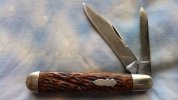I believe it was Remington who in the early 1900's (pre-1910) determined the "average" life of a pocketknife (regardless of brand and price point) was between three to five years.
Loss, sharpened to a "toothpick", broken blade(s) were the main reasons.
Recall, back then the "average" "person" owned one pocketknife, and if a "sportsman" (partook in hunting, fishing, camping, etc.) possibly a fixed blade (or folding) hunting knife or fillet knife.
Obviously there are some pocketknives that were properly cared for: lubed regularly, stropped more than sharpened on a stone, grinder, or using a file, etc. that have lasted much longer with minimal blades loss, and no broken blades.
I have a 1911 to 1921 Robeson 'English Jack' which from what I can tell has little to no blade loss.
Recall: Back then the "average" "person" used their pocketknife as a tool several times a day, regardless of profession.
For the most part they didn't have several knives to spread the wear over.
I also "think" many of the surviving early 20th century knives had (have?) a stiff/hard pull, were put in a sock drawer, and replaced for a knife they didn't have to fight to open ... tho I may be mistaken on that.


